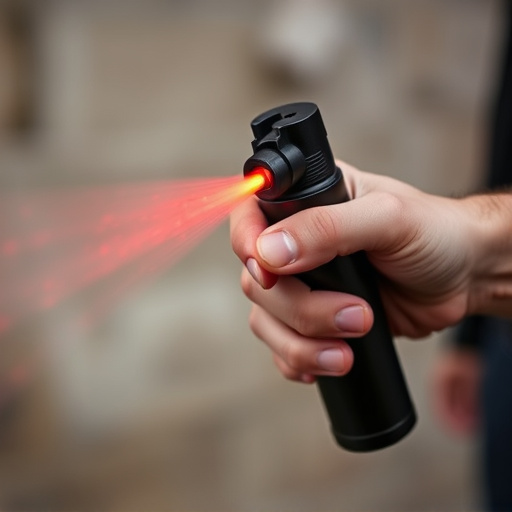Removing pepper spray residue from clothing requires specialized knowledge of its active ingredient, capsaicin. Traditional and home cleaning methods often fail due to capsaicin's complexity. Neutralizing agents, thorough washing, and rinsing are recommended. Soaking in warm water and dish soap, vinegar mixes, or commercial detergents can help. Immediate action post-exposure is crucial, including removing contaminated clothing, washing with hot water and detergent, and rinsing skin thoroughly. Aftercare involves cooling affected areas, using eye drops/damp cloths, and wearing protective eyewear for several days. Medical attention is advised for severe symptoms. Key step: remove pepper spray from clothing effectively.
“Uncover the powerful compound that is police-grade inflammatory pepper spray and its significant effects. This article delves into the intricate details of pepper spray composition, exploring how it interacts with various fabrics. We provide effective strategies for removing pepper spray from clothing, offering essential aftercare tips to prevent and manage exposure. Discover preventative measures to safeguard against this potent agent, ensuring your safety and comfort.”
- Understanding Pepper Spray Composition and Its Impact on Fabric
- Effective Methods to Remove Pepper Spray from Clothing
- Preventative Measures and Aftercare for Pepper Spray Exposure
Understanding Pepper Spray Composition and Its Impact on Fabric
Pepper spray, a common less-lethal weapon used by law enforcement, is composed of capsaicin, a compound derived from chili peppers. This chemical irritates the eyes and respiratory system when it comes into contact, causing temporary blindness, coughing, and difficulty breathing. The potency of pepper spray can vary depending on its composition; higher concentrations can lead to more severe reactions. One notable aspect of pepper spray’s impact is its ability to adhere to fabrics, making removal a challenging process. This persistence on clothing is due to the compound’s oily nature, which allows it to penetrate fiber materials, making simple washing less effective in removing it completely.
When dealing with pepper spray residue on clothing, understanding its composition becomes crucial for effective removal. Traditional cleaning methods may not suffice because capsaicin can remain active even after drying. Specialized solutions and techniques are required to break down and remove the compound effectively. Home remedies like soaking in vinegar or using baby shampoo have varying levels of success due to the unique properties of each ingredient and the complexity of pepper spray’s composition. For best results, removing pepper spray from clothing involves using specialized cleaning agents designed to neutralize capsaicin, followed by thorough washing and rinsing.
Effective Methods to Remove Pepper Spray from Clothing
Removing pepper spray from clothing can be a challenging task due to its sticky and persistent nature. However, there are several effective methods that can help minimize the impact of this irritant. One of the most common and accessible solutions is using a mixture of water and dish soap. Soaking the affected area in a solution of warm water and mild dishwashing liquid can help break down the pepper spray’s chemical composition. After soaking for about 15-20 minutes, gently rub the fabric with your hands or a soft brush to aid in removing the residue.
Another natural and safe approach involves using white vinegar. Vinegar’s acetic acid properties can effectively cut through the oil-based pepper spray. Soak the clothing in a mixture of equal parts water and vinegar for around an hour, then rinse thoroughly with cold water. For stubborn stains, repeat the process or consider using a commercial laundry detergent designed to remove grease and oil-based stains, as pepper spray shares similar characteristics. Always test any cleaning solution on a small inconspicuous area first to ensure it doesn’t cause discoloration or damage to the fabric.
Preventative Measures and Aftercare for Pepper Spray Exposure
After exposure to pepper spray, immediate preventative measures are crucial. If clothing has been contaminated, it’s important to quickly remove the affected garments and wash them separately in hot water with a strong detergent. This helps to prevent the spread of the chemical and ensures that any residual spray is removed. It’s also vital to thoroughly rinse any skin or eye contact areas with plenty of clean water for at least 15 minutes. Seeking medical attention may be necessary if symptoms persist or worsen, as pepper spray can cause respiratory distress or other health issues.
Aftercare is an essential aspect of managing pepper spray exposure. Keeping the affected area cool and calm can aid in reducing discomfort. Using a fan to direct fresh air onto the skin or eyes can provide relief from irritation. Moisturizing eye drops or clean, damp cloths applied to the face and eyes can help alleviate stinging sensations. Additionally, wearing protective eyewear for several days afterward is recommended to prevent further eye irritation.
In understanding the impact of pepper spray, especially its composition and effect on fabric, it becomes crucial to also equip ourselves with effective removal methods. The ability to promptly remove pepper spray residue from clothing is a key step in mitigating discomfort and potential health risks associated with exposure. By adopting the right techniques and preventative measures discussed in this article, individuals can better navigate situations involving pepper spray, ensuring their safety and comfort. Remember, quick action when addressing pepper spray contact with clothing is essential for effective removal.
